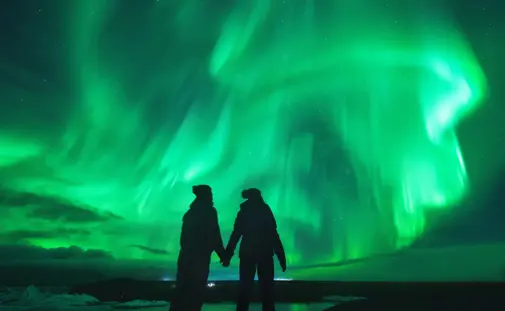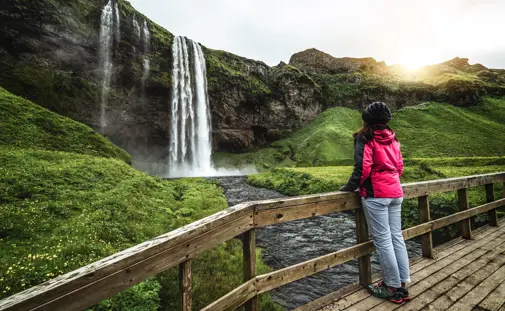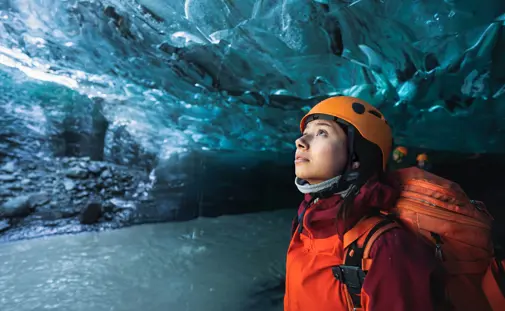Mýrdalsjökull is one of Iceland's largest glaciers, covering an area of approximately 595 square kilometers (230 square miles) in the southern part of the country. This massive ice cap sits atop the notorious Katla volcano, one of Iceland’s most active and powerful volcanoes. The glacier’s rugged terrain, shaped by the interplay of volcanic and glacial forces, creates a stunning landscape of ice formations, crevasses, and ridges that attract adventurers and nature enthusiasts from around the world.
Beneath the surface of Mýrdalsjökull, the Katla volcano has the potential to produce explosive eruptions, which can lead to jökulhlaups, or glacial floods, as the ice rapidly melts. Despite the hidden power beneath, the glacier itself is a popular destination for outdoor activities, including glacier hiking, snowmobiling, and ice cave exploration. The views from the glacier are breathtaking, with vistas stretching across the South Coast and the surrounding highlands.
Mýrdalsjökull is also part of the larger Katla Geopark, a region rich in geological wonders, where visitors can learn about the dynamic forces that have shaped this unique landscape.
Mýrdalsjökull Glacier Facts
Mýrdalsjökull is a vast glacier with impressive statistics:
-
Size: Covers 595 km² (230 square miles)
-
Thickness: Average ice thickness is 200-700 meters
-
Height: The highest point of Mýrdalsjökull reaches approximately 1,493 meters (4,898 feet) above sea level
-
Age: Formed during the last ice age
-
Volcanic Activity: Mýrdalsjökull sits on top of the active Katla volcano, which last erupted in 1918
-
Meltwater Rivers: Glacial melt feeds several rivers in the region, significantly shaping the surrounding landscape
Mýrdalsjökull and Surrounding Area
The Mýrdalsjökull Glacier is more than just a large ice cap—it's an integral part of the environment and landscape around it. The glacier nourishes several rivers that run into nearby fjords and coastal areas, helping to shape Iceland’s unique terrain. Its location on the southern tip of Iceland, near the town of Vík, makes it a prominent feature of the region, blending the power of ice with volcanic forces beneath the surface. The glacier also contributes to the vibrant ecosystems in the area, providing a stunning contrast of frozen beauty against the lush, green lowlands during the summer months.
Mýrdalsjökull and Katla Volcano
The connection between Mýrdalsjökull and Katla volcano is both fascinating and perilous. Katla is one of Iceland’s largest and most active volcanoes, sitting directly beneath the glacier. The volcano erupts roughly every 40 to 80 years, with the last recorded eruption in 1918. Due to Katla’s location under the ice cap, eruptions are often accompanied by glacial flooding, known as jökulhlaups, which can cause significant damage to the surrounding areas. Katla's eruptions also impact the glacier itself, with volcanic ash and debris becoming embedded in the ice, visible in the striking dark layers of ice seen in parts of the glacier.
Mýrdalsjökull Ice Caves
Mýrdalsjökull is home to some of Iceland’s most spectacular ice caves, which are formed as glacial meltwater carves tunnels through the ice. These caves are dynamic, changing in shape and size each year as the glacier moves. One of the most famous is the Katla Ice Cave, located in Kötlujökull, an outlet glacier of Mýrdalsjökull. The Katla Ice Cave is accessible year-round and is celebrated for its striking mix of blue and black ice, with volcanic ash from previous Katla eruptions frozen within its layers. Exploring these ice caves is a magical experience, but visitors are advised to only enter with trained guides, as the caves can be dangerous without proper knowledge and equipment.
Where is Mýrdalsjökull?
Mýrdalsjökull Glacier is located in South Iceland, near the town of Vík. It lies just west of Eyjafjallajökull and stretches over the southern highlands.
-
The GPS coordinates are 63.6350° N, 19.0561° W.
Map of Mýrdalsjökull and Surroundings
How to Get to Mýrdalsjökull?
To reach Mýrdalsjökull from Reykjavík, drive east on Route 1 (Ring Road) for approximately 160 km (100 miles) until you reach Vík. From there, follow the local signs and marked routes leading to glacier activities. If you're coming from Höfn, travel west along Route 1 for 260 km (161 miles). Guided tours are the best way to explore Mýrdalsjökull up close, especially for ice cave or glacier hikes, as they provide the necessary safety gear and expert knowledge.
Many guided tours will visit Solheimajokull which is an outlet glacier of Myrdalsjokull glacier. To reach the area closest to Sóllheimajökull you'll turn off the ring road onto road 221, a paved road that takes about 6 minutes to the edge of the glacier.
If you plan on reaching Þakgil campsite that's close to the glacier, drive past the town of Vík for about 5 minutes and turn left onto the Kerlingadalsvegur. Follow Kerlingadalsvegur for about 30 minutes and you'll find the campsite. The road is mostly gravel and narrow so make sure to drive slow.
Nearby Attractions
Mýrdalsjökull Glacier is surrounded by some of Iceland's most famous natural wonders:
-
Reynisfjara Black Sand Beach: A famous beach known for its black volcanic sand and basalt columns, located near Vík.
-
Skógafoss Waterfall: One of Iceland’s largest and most iconic waterfalls, located about 30 km from the glacier.
-
Dyrhólaey: A striking promontory with stunning views of the surrounding coastlines and home to puffin colonies during the summer.
-
Fimmvörðuháls Hiking Trail: An extraordinary hike between two glaciers, Eyjafjallajökull and Mýrdalsjökull, offering breathtaking views and challenging terrain.
Nearby Accommodation
Visitors to Mýrdalsjökull will find several accommodation options nearby:
Hotels
-
Hótel Kría in Vík offers modern accommodations with views of the surrounding mountains and glacier.
-
Hotel Vík provides upscale lodging near Vík with easy access to the glacier.
Camping
-
Vík Camping Ground is located close to the glacier, offering basic amenities for campers and as it's within the town of Vík you'll have access to basic amenities.
-
Þakgil Campsite provides a more secluded camping experience, surrounded by nature and only a short drive from the glacier. It's the ideal remote camping adventure you're looking for in Iceland.




